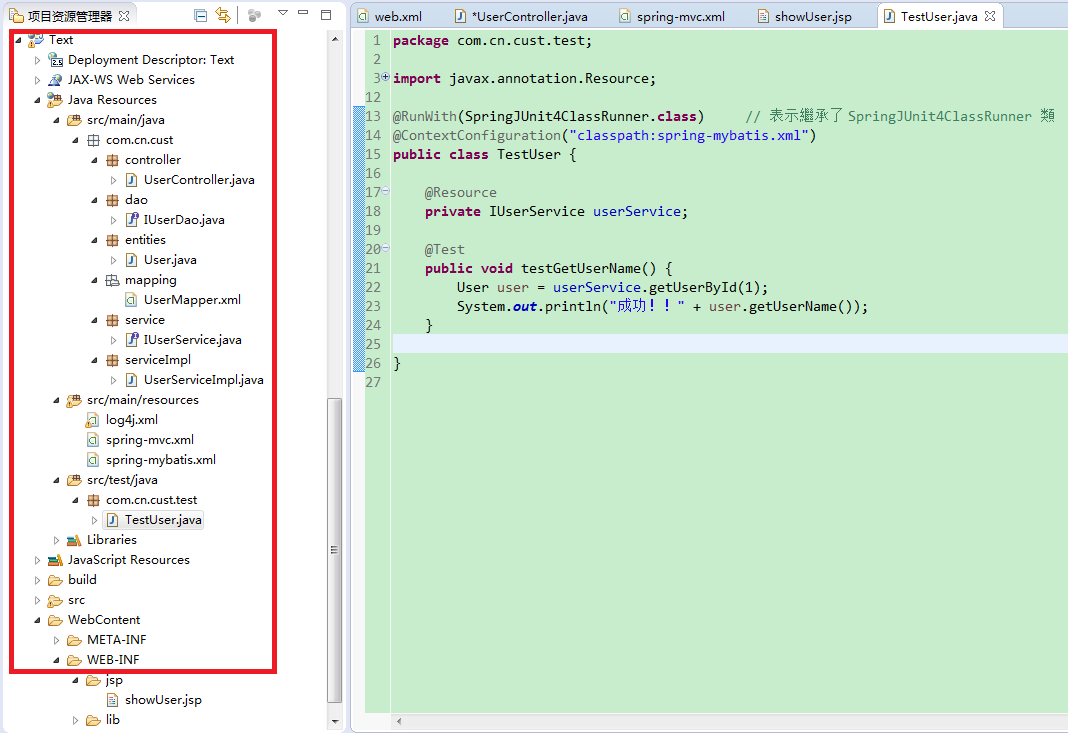SSM框架(一)之SSM框架整合(Spring,SpringMVC,MyBatis)
一、基本概念
最近做一個Web網站,選擇了使用SSM框架,SSM框架下的Web程式主要用到了三個技術:
1. Spring:用到了註解和自動裝配,就是Spring的兩個精髓IOC(反向控制)和 AOP(面向切面程式設計)。
2. SpringMVC:用到了MVC模型,將邏輯程式碼放到Controller層處理。
3. MyBatis:用到了與資料庫打交道的層面,放在所有的邏輯之後,處理與資料庫的CRUD相關的操作。
二、SSM框架下程式碼完成步驟
- 先寫實體類Entity,定義物件的屬性(可以參照資料庫中表的欄位來設定,資料庫的設計應該在所有編碼開始之前)。
- 寫Mapper.xml(Mybatis),其中定義你的功能,對應要對資料庫進行的那些操作,比如 insert、selectAll、selectByKey、delete、update等。
- 寫Dao.java,將Mapper.xml中的操作按照id對映成Java函式。
- 寫Service.java,為控制層提供服務,接受控制層的引數,完成相應的功能,並返回給控制層。
- 寫Controller.java,連線頁面請求和服務層,獲取頁面請求的引數,通過自動裝配,對映不同的URL到相應的處理函式,並獲取引數,對引數進行處理,之後傳給服務層。
寫JSP頁面呼叫,請求哪些引數,需要獲取什麼資料。
歸納起來就是:
DataBase ===> Entity ===> Mapper.xml ===> Dao.java ===> Service.java ===> Controller.java ===> Jsp三、SSM整合
整合後完整的目錄結構如下:
3.1、引入相關jar包
將所需的jar包複製貼上到WebContent\WEB-INF\lib資料夾下面
3.2、Spring與MyBatis的整合
所有需要的JAR包都引入以後,首先進行Spring與MyBatis的整合,然後再進行JUnit測試
3.2.1、建立spring-mybatis.xml配置檔案
這個檔案就是用來完成spring和mybatis的整合的。這裡面也沒多少行配置,主要的就是自動掃描,自動注入,配置資料庫。註釋也很詳細,大家看看就明白了。
spring-mybatis.xml
<?xml version="1.0" encoding="UTF-8"?> 3.2.2、Log4j的配置
<?xml version="1.0" encoding="UTF-8" ?>
<!DOCTYPE log4j:configuration SYSTEM "log4j.dtd">
<log4j:configuration>
<appender name="STDOUT" class="org.apache.log4j.ConsoleAppender">
<layout class="org.apache.log4j.PatternLayout">
<param name="ConversionPattern" value="%-5p %d{MM-dd HH:mm:ss,SSS} %m (%F:%L) \n" />
</layout>
</appender>
<logger name="java.sql">
<level value="debug" />
</logger>
<logger name="org.apache.ibatis">
<level value="debug" />
</logger>
<root>
<level value="debug" />
<appender-ref ref="STDOUT" />
</root>
</log4j:configuration>
3.2.3、JUnit測試
經過以上步驟(到3.2.2,log4j不配也沒影響),我們已經完成了Spring和mybatis的整合,這樣我們就可以編寫一段測試程式碼來試試是否成功了。
3.2.3.1、建立測試用表
既然我們需要測試,那麼我們就需要建立在資料庫中建立一個測試表,這個表建的很簡單,SQL語句為:
DROP TABLE IF EXISTS `user_t`;
CREATE TABLE `user_t` (
`id` int(11) NOT NULL AUTO_INCREMENT,
`user_name` varchar(40) NOT NULL,
`password` varchar(255) NOT NULL,
`age` int(4) NOT NULL,
PRIMARY KEY (`id`)
) ENGINE=InnoDB AUTO_INCREMENT=2 DEFAULT CHARSET=utf8;
/*Data for the table `user_t` */
insert into `user_t`(`id`,`user_name`,`password`,`age`) values (1,'測試','sfasgfaf',24); 3.2.3.2、根據資料表user_t建立實體類User
package com.cn.cust.entities;
public class User {
private Integer id;
private String userName;
private String password;
private Integer age;
public Integer getId() {
return id;
}
public void setId(Integer id) {
this.id = id;
}
public String getUserName() {
return userName;
}
public void setUserName(String userName) {
this.userName = userName;
}
public String getPassword() {
return password;
}
public void setPassword(String password) {
this.password = password;
}
public Integer getAge() {
return age;
}
public void setAge(Integer age) {
this.age = age;
}
@Override
public String toString() {
return "User [id=" + id + ", userName=" + userName + ", password=" + password + ", age=" + age + "]";
}
}
3.2.3.3、Mapping層
<?xml version="1.0" encoding="UTF-8"?>
<!DOCTYPE mapper PUBLIC "-//mybatis.org//DTD Mapper 3.0//EN"
"http://mybatis.org/dtd/mybatis-3-mapper.dtd">
<mapper namespace="com.cn.cust.dao.IUserDao">
<resultMap type="User" id="userResult">
<result column="id" property="id"></result>
<result column="user_name" property="userName"></result>
<result column="password" property="password"></result>
<result column="age" property="age"></result>
</resultMap>
<insert id="save" keyColumn="id" keyProperty="id" useGeneratedKeys="true">
insert into user_t (user_name, password, age) values (#{user_name}, #{password}, #{age})
</insert>
<update id="update" parameterType="user">
update user_t set user_name = #{user_name}, password = #{password}, age = #{age}
where id = #{id}
</update>
<delete id="delete" parameterType="int">
delete from user_t where id = #{id}
</delete>
<select id="findById" parameterType="int" resultMap="userResult">
select * from user_t where id = #{id}
</select>
<select id="getAll" resultType="User">
SELECT * FROM user_t
</select>
</mapper>3.2.3.4、持久層
package com.cn.cust.dao;
import java.util.ArrayList;
import com.cn.cust.entities.User;
/**
*
* @author HuangMinghao 持久層,資料訪問物件
*/
public interface IUserDao {
void save(User user);
void update(User user);
void delete(int id);
User findById(int id);
ArrayList<User> getAll();
}
3.2.3.5、建立Service介面和實現類
IUserService.jave
package com.cn.cust.service;
import com.cn.cust.entities.User;
public interface IUserService {
public User getUserById(int userId);
}
UserServiceImpl.java
package com.cn.cust.serviceImpl;
import javax.annotation.Resource;
import org.springframework.stereotype.Service;
import com.cn.cust.dao.IUserDao;
import com.cn.cust.entities.User;
import com.cn.cust.service.IUserService;
@Service("userService")
public class UserServiceImpl implements IUserService {
@Resource
private IUserDao userDao;
@Override
public User getUserById(int userId) {
return this.userDao.findById(userId);
}
}
3.2.3.6、建立測試類
測試類在src/test/java中建立, 如果測試成功,表示 Spring 和 Mybatis 已經整合成功了 。輸出資訊使用的是 Log4j 列印到控制檯。
package com.cn.cust.test;
import javax.annotation.Resource;
import org.junit.Test;
import org.junit.runner.RunWith;
import org.springframework.test.context.ContextConfiguration;
import org.springframework.test.context.junit4.SpringJUnit4ClassRunner;
import com.cn.cust.entities.User;
import com.cn.cust.service.IUserService;
@RunWith(SpringJUnit4ClassRunner.class) // 表示繼承了 SpringJUnit4ClassRunner 類
@ContextConfiguration("classpath:spring-mybatis.xml")
public class TestUser {
@Resource
private IUserService userService;
@Test
public void testGetUserName() {
User user = userService.getUserById(1);
System.out.println("成功!!" + user.getUserName());
}
}
測試結果:

至此, 完成Spring和mybatis這兩大框架的整合 ,下面在繼續進行SpringMVC的整合。
3.3、整合SpringMVC
上面已經完成了2大框架的整合,SpringMVC的配置檔案單獨放,然後在web.xml中配置整合
3.3.1、配置spring-mvc.xml
配置裡面的註釋也很詳細,在此就不說了,主要是 自動掃描控制器,檢視模式,註解的啟動 這三個。
<?xml version="1.0" encoding="UTF-8"?>
<beans xmlns="http://www.springframework.org/schema/beans"
xmlns:xsi="http://www.w3.org/2001/XMLSchema-instance" xmlns:context="http://www.springframework.org/schema/context"
xmlns:mvc="http://www.springframework.org/schema/mvc"
xsi:schemaLocation="http://www.springframework.org/schema/beans
http://www.springframework.org/schema/beans/spring-beans.xsd
http://www.springframework.org/schema/context http://www.springframework.org/schema/context/spring-context.xsd
http://www.springframework.org/schema/mvc http://www.springframework.org/schema/mvc/spring-mvc.xsd">
<!-- 自動掃描該包,使SpringMVC認為包下用了@controller註解的類是控制器 -->
<context:component-scan base-package="com.cn.hnust.controller" />
<!-- 啟動SpringMVC的註解功能,完成請求和註解POJO的對映 -->
<context:component-scan base-package="com.cn.cust"
use-default-filters="false">
<context:include-filter type="annotation"
expression="org.springframework.stereotype.Controller" />
<context:include-filter type="annotation"
expression="org.springframework.web.bind.annotation.ControllerAdvice" />
</context:component-scan>
<!-- 定義跳轉的檔案的前後綴 ,檢視模式配置 -->
<bean
class="org.springframework.web.servlet.view.InternalResourceViewResolver">
<!-- 這裡的配置我的理解是自動給後面action的方法return的字串加上字首和字尾,變成一個 可用的url地址 -->
<property name="prefix" value="/WEB-INF/jsp/" />
<property name="suffix" value=".jsp" />
</bean>
<mvc:default-servlet-handler />
<mvc:annotation-driven />
</beans>3.3.2、配置web.xml檔案
這裡面對spring-mybatis.xml的引入以及配置的spring-mvc的Servlet就是為了完成SSM整合,之前2框架整合不需要在此處進行任何配置。配置一樣有詳細註釋,不多解釋了。
web.xml
<?xml version="1.0" encoding="UTF-8"?>
<web-app xmlns:xsi="http://www.w3.org/2001/XMLSchema-instance"
xmlns="http://java.sun.com/xml/ns/javaee"
xsi:schemaLocation="http://java.sun.com/xml/ns/javaee http://java.sun.com/xml/ns/javaee/web-app_2_5.xsd"
id="WebApp_ID" version="2.5">
<display-name>Text</display-name>
<welcome-file-list>
<welcome-file>index.html</welcome-file>
<welcome-file>index.htm</welcome-file>
<welcome-file>index.jsp</welcome-file>
<welcome-file>default.html</welcome-file>
<welcome-file>default.htm</welcome-file>
<welcome-file>default.jsp</welcome-file>
</welcome-file-list>
<!-- spring 和 mybatis 的配置檔案 -->
<context-param>
<param-name>contextConfigLocation</param-name>
<param-value>classpath:spring-mybatis.xml</param-value>
</context-param>
<!-- Spring 監聽器 -->
<listener>
<listener-class>org.springframework.web.context.ContextLoaderListener</listener-class>
</listener>
<!-- 防止 Spring 記憶體溢位監聽器 -->
<listener>
<listener-class>org.springframework.web.util.IntrospectorCleanupListener</listener-class>
</listener>
<!-- Spring MVC servlet -->
<servlet>
<servlet-name>springDispatcherServlet</servlet-name>
<servlet-class>org.springframework.web.servlet.DispatcherServlet</servlet-class>
<init-param>
<param-name>contextConfigLocation</param-name>
<param-value>classpath:spring-mvc.xml</param-value>
</init-param>
<load-on-startup>1</load-on-startup>
</servlet>
<servlet-mapping>
<servlet-name>springDispatcherServlet</servlet-name>
<url-pattern>/</url-pattern>
</servlet-mapping>
<!-- 編碼過濾器 -->
<filter>
<filter-name>encodingFilter</filter-name>
<filter-class>org.springframework.web.filter.CharacterEncodingFilter</filter-class>
<init-param>
<param-name>encoding</param-name>
<param-value>utf-8</param-value>
</init-param>
</filter>
<filter-mapping>
<filter-name>encodingFilter</filter-name>
<url-pattern>/*</url-pattern>
</filter-mapping>
<!-- 配置 HiddenHttpMethodFilter : 把 Post 請求轉化為 DELETE,PUT請求 -->
<filter>
<filter-name>HiddenHttpMethodFilter</filter-name>
<filter-class>org.springframework.web.filter.HiddenHttpMethodFilter</filter-class>
</filter>
<filter-mapping>
<filter-name>HiddenHttpMethodFilter</filter-name>
<url-pattern>/*</url-pattern>
</filter-mapping>
</web-app>3.3.3、測試
至此已經完成了SSM三大框架的整合了,接下來測試一下,如果成功了,那麼恭喜你,如果失敗了,繼續除錯吧, 作為程式設計師就是不停的與BUG做鬥爭 !
3.3.3.1、新建jsp頁面
showUser.jsp 此頁面僅輸出一下使用者名稱,完成一個 完整的簡單流程 。
<%@ page language="java" contentType="text/html; charset=utf-8"
pageEncoding="utf-8"%>
<!DOCTYPE html PUBLIC "-//W3C//DTD HTML 4.01 Transitional//EN" "http://www.w3.org/TR/html4/loose.dtd">
<html>
<head>
<meta http-equiv="Content-Type" content="text/html; charset=utf-8">
<title>測試</title>
</head>
<body>
${user.userName}
</body>
</html>3.3.3.2、建立UserController類
UserController.java 控制器
package com.cn.cust.controller;
import javax.annotation.Resource;
import javax.servlet.http.HttpServletRequest;
import org.springframework.stereotype.Controller;
import org.springframework.ui.Model;
import org.springframework.web.bind.annotation.RequestMapping;
import com.cn.cust.entities.User;
import com.cn.cust.service.IUserService;
/**
* 引數傳遞,最簡單的DEMO
*/
@Controller
@RequestMapping("/user")
public class UserController {
@Resource
private IUserService userService;
@RequestMapping("/showUser")
public String toIndex(HttpServletRequest request,Model model) {
int userId = Integer.parseInt(request.getParameter("id"));
User user = this.userService.getUserById(userId);
model.addAttribute("user",user);
return "showUser";
}
}
3.3.3.3、部署專案
輸入地址: localhost:8080/ 專案名稱 /user/showUser?id=1

至此,SSM三大框架的整合就完成了,在此基礎上可再新增其他功能。


